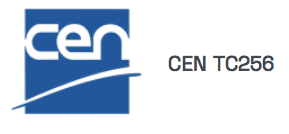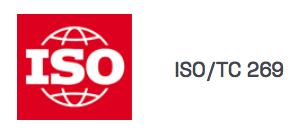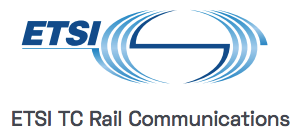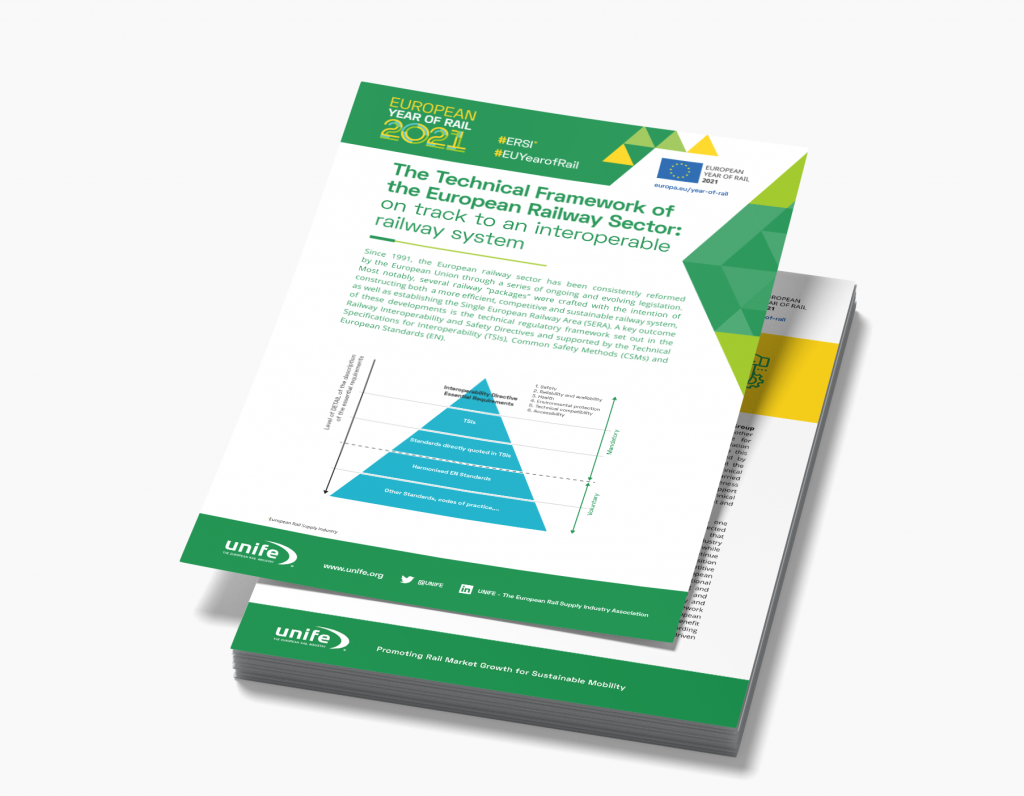Interactive Factsheet
The Technical Framework of the European Railway Sector: on track to an interoperable railway system
Since 1991, the European railway sector has been consistently reformed by the European Union through a series of ongoing and evolving legislation. Most notably, several railway “packages” were crafted with the intention of constructing both a more efficient, competitive and sustainable railway system, as well as establishing the Single European Railway Area (SERA). A key outcome of these developments is the technical regulatory framework set out in the Railway Interoperability and Safety Directives and supported by the Technical Specifications for Interoperability (TSIs), Common Safety Methods (CSMs) and European Standards (EN).
The TSIs define the technical and operational standards which must be met by each subsystem – or part of subsystem – to fulfill essential requirements of the Directive and ensure the interoperability of the EU’s railway system.
11 TSIs in publication
- Control Command and Signalling
- Energy
- Infrastructure
- Noise
- Operation and Traffic Management
- Persons with Disabilities and with Reduced Mobility
- Rolling Stock – Locomotives and Passengers
- Rolling Stock – Freight Wagons
- Safety in Railway Tunnels
- Telematics Applications for Passenger service
- Telematics
Applications for Freight service The TSIs are drafted by the European Union Agency for Railways (ERA), on a mandate from the European Commission (EC). The working parties set up for this include expert nominations from the National Safety Authorities (NSAs) and sector Representative Bodies – which includes UNIFE, on behalf of the European Rail Supply Industry. The next revision of the TSIs is currently being prepared. On 24 January 2020, the EC sent a request to the ERA for the preparation of the Digital rail and Green freight TSI revision package, expected to be released in 2022. This package is intended to align the TSIs’ contents with the EC’s high-level policy goals.
The UNIFE Standards and Regulations Group (SRG), supported by the association’s other Technical Working Groups, is responsible for monitoring developments in both the regulation and standardisation fields, which make up this technical regulatory framework represented by the pyramid. UNIFE’s goal is to ensure that the necessary evolution of this complex technical regulation and standards framework is carried out in a way that will improve the competitiveness of the European Rail Supply Industry, support the harmonisation and transparency of technical rules in Europe and facilitate the development and authorisation of rail products.
Concerning the TSI 2022 revision package, one of UNIFE’s priorities is the review and expected amendments to its transitional provisions that are required to provide the rail supply industry with stability for individual railway projects while regulations, standards and innovations continue to evolve. UNIFE has recently published a Position Paper, titled TSI Transitions for a Competitive European Railway Sector, outlining the European rail supply industry stances on the transitional provisions needed to support the planning and competitiveness of long-term rail projects and delivery of vehicle types. Increased stability and predictability of the European technical framework and TSI transitions is a priority for the European rail supply industry. The sector must benefit from today’s TSI maturity – especially regarding interoperability, safety and from market-driven product innovations
European and International Standardisation:
supporting harmonisation and a competitive global railway market
Technical standards enable interoperability of products and technologies by defining specifications. Their application remains voluntary unless required by legislation or contractual agreements. For the European rail supply industry, standardisation is key to improving quality, reducing cost and increasing competitiveness. In the EU, harmonised standards provide presumption of conformity with legal requirements. In addition, the railway sector referenced standard are standards (or parts of a standard) which are referenced in a TSI.
The application of a standard referenced in a TSI remains mandatory even when a newer version of the same standard may be listed in the Official Journal of the European Union (OJEU) as a harmonised standard. For fulfilling the requirements of the TSI, there is currently no free choice of the version of the standard in this respect.
The 2022 TSI package will allow increased flexibility: on a case-by-case basis, the new TSIs will introduce the option to use a newer version of a standard and leave the applicant the choice between the older or the newer version, provided the newer version is still considered to fulfil the needs of the Directive and related TSI.
It is also foreseen to allow limited TSI revisions to update an appendix when a newer version of a referenced standard has become available.
In total, the TSIs today reference 143 standards. Since the maintenance of this complex system is highly challenging, a reduction of the number of referenced standards is desirable for the sector. The Sector Forum Rail, advisory body of CEN-CENLEC, has elaborated a decision matrix to determine for each standard whether they should remain voluntary or be referenced in the TSIs.
Today, most standards for the railway sector are European Norms but also several international standards (ISO/IEC) exist.
International standardisation activity at the International Standards Organisation (ISO) and the International Electrotechnical Commission (IEC) is increasingly gaining importance. Also, standardisation activity outside the railway standardisation committees – notably, in the digital area – is becoming more relevant for rail. Good coordination between the European and international level, as well as the right strategy regarding where to develop standards are crucial for the future of rail standardisation. An increased use of digital tools in the standard-making process is also helping facilitate participation in standardisation work at all levels.
Rail Standardisation in Europe

Your content goes here. Edit or remove this text inline or in the module Content settings. You can also style every aspect of this content in the module Design settings and even apply custom CSS to this text in the module Advanced settings.
304 published standards
144 under development Scope:
Standardisation of all applications (except electrical and electronic subjects), in the field of railways, including urban transport and specifically intended for vehicles and fixed installations

304 published standards
144 under development Scope:
Standardisation of all applications (except electrical and electronic subjects), in the field of railways, including urban transport and specifically intended for vehicles and fixed installations
International Rail Standardisation

15 published standards
25 under development Scope:
Standardisation of all systems, products and services specifically related to the railway sector, including design, manufacture, construction, operation, and maintenance of parts and equipment, methods and technology, interfaces between infrastructure, vehicles and the environment, excluding those electrotechnical and electronic products and services for railways – which are within the scope of IEC/TC 9.

15 published standards
25 under development Scope:
Standardisation of all systems, products and services specifically related to the railway sector, including design, manufacture, construction, operation, and maintenance of parts and equipment, methods and technology, interfaces between infrastructure, vehicles and the environment, excluding those electrotechnical and electronic products and services for railways – which are within the scope of IEC/TC 9.

2 published EN standards
51 technical documents Scope:
responsible for the development and maintenance of standards related to GSM-R (GSM™ for railways) as well as Next Generation Radio for Rail (NG2R).
143 Standards currently referenced in TSIs
European and International Standardisation:
supporting harmonisation and a competitive global railway market
4RP is a set of 6 legislative texts designed to complete the single market for Rail services (Single European Railway Area). The ‘technical pillar’ was adopted by the European Parliament and the Council in April 2016 and comprises:
- Regulation (EU) 2016/796 on the European Union Agency for Railways and repealing Regulation (EC) n° 881/2004
- Directive (EU) 2016/797 on the interoperability of the rail system within the European Union (Recast of Directive 2008/57/EC)
- Directive (EU) 2016/798 on railway safety (Recast of Directive 2004/49/EC)
- Boost the competitiveness of the railway sector by significantly reducing costs and administrative burden;
- Save businesses from having to file multiple, costly applications for vehicle authorisations and safety certificates in the case of operations beyond one single member state;
- Create a ‘one-stop shop’ IT tool which will act as a single-entry point for all such applications, using easy, transparent and consistent procedures;
- Harmonise the implementation of the European Rail Traffic Management System (ERTMS);
- Reduce the large number of national rules and make them more transparent.
Transposition and Entry into Operation of the 4RP by Member States
We are now approaching the two-year anniversary of Bulgaria, Finland, France, Greece, Italy, the Netherlands, Romania and Slovenia’s adoption the Fourth Railway Package’s Technical Pillar regime on 16 June 2019.
In this time, ERA has delivered more than: 1.500 vehicle authorisation decisions, comprising upwards of 17.000 authorised rail vehicles.
A harmonised European authorisation process ran by the newly fortified ERA should result in a convergence and greater certainty of requirements. It will also result in a more consistent, quicker and cheaper process with less duplication of checks and testing. With the entry into operation of the Technical Pillar in all Member States at the end of 2020, close attention will be paid in the coming years to ensuring the full delivery of the Fourth Railway Package’s expected benefits.
Notified National Technical Rules are an essential tool for the management of national legacy systems, the presence and enforcement of national rules preserves the benefits of national interoperability and prevents further national system diversity beyond the minimum needed during the transition to the target system as set out in the TSI.
National rules only apply in the following circumstances:
- Technical compatibility (to ensure technical compatibility with the legacy rail system where it is not designed and built to TSIs)
- Specific cases (where special provisions in the TSIs, either temporary or permanent, are needed for any part of the rail system)
- Open points (where a national rule provides a solution for the open point).
Since 2016, the ERA and NSAs have been undertaking an extensive programme for the clean-up of unnecessary national rules. Minimising and eventually removing the National Technical Rules on top of the optimum level of technical harmonisation as defined in the TSIs is fundamental in removing the remaining technical barriers, promoting interoperability, facilitating the authorisation of railway vehicles and ultimately benefiting from the Fourth Railway Package Technical Pillar processes.
Since beginning the clean-up programme, the number of NNTRs relevant for vehicle authorisation has been reduced from 14312 to around 1000 at the present time. The finalisation of the rules clean-up by all Member States based on ERA’s assessment remains to be completed, so the final number is expected to be still far lower. UNIFE is continuing to carefully monitor the finalisation of this activity and the targeted establishment of a minimum clear and comprehensive set of rules (TSIs and necessary NNTRs).
Evolution of NRs for Vehicle Autorisation in addition to latest TSIs
